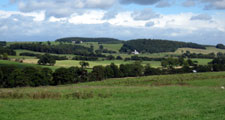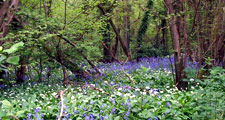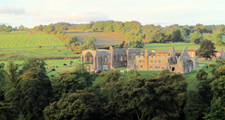Woodlands in the Dales Fringe
Existing Woodland
The narrow gorge of the River Tees and the incised denes of its tributaries, most notably the Deepdale Beck and the River Greta, are lined with ancient woodlands. Away from the river corridors the landscape is fairly open with scattered plantations, small copses and shelterbelts. Heavily wooded parklands are a notable feature of the area, many incorporating areas of replanted or heavily modified ancient woodland.
Native Woods
The riverside and dene woodlands of the Dales Fringe contain a range of ground conditions which are reflected in the woodland communities they support. On exposed Carboniferous limestones, ash woodland communities transitional between lowland and upland types are found. Oak woodland communities – including those with lowland and upland characteristics – occur on more acidic substrates and are likely to have been much more widespread in the past on the neutral gleys and brown earths which cover much of the area. Upland oak and oak -birch woodlands are also likely to have been more extensive in the upland fringes: only isolated fragments survive today. Alder-ash communities are found on flushed slopes in ravine woodlands. Alder carr woodland is found on wet fertile soils on the margins of ponds and wetlands. Valley Fen Alderwood occurs in small pockets on seasonally flooded land along the river. Scrub occurs in patches on disturbed ground, old railway lines, road verges and steep pastures.
Characteristic native woodland types in the Dales Fringe (identified here by their National Vegetation Class) include:
- Lowland Ash Woodland – NVC W8
- Upland Ash Woodland- W9
- Lowland Oak Woodland – W10
- Upland Oak Birch Woodland – W11
- Upland Oak Birch Woodland – W17
- Alder Ash Woodland – W7
- Alder Carr Woodland – W5
- Valley Fen Alder Woodland – W6
- Hawthorn Scrub – W21
- Blackthorn Scrub – W22
- Gorse Scrub – W23
- Bramble Scrub – W24/25
nformation on the typical structure and species composition of these particular native woodland communities, distribution and guidelines on their management, and suitable sites for new planting can be found by clicking on the links above or by downloading the following pdf:
Native Woodland Types (PDF, 598kb)
Woodlands in the Dales Fringe tend to be actively managed as many form part of larger estates where they are managed under Woodland Grant Scheme contracts. The area does contain a large number of replanted or heavily modified ancient woodland sites – including both dene woods and larger woods on better ground.
Objectives for the areas existing native woods include:
- Conserving and restoring semi-natural oak and ash woodlands in denes and on riverbanks.
- Restoring replanted or modified ancient woodlands.
Plantations
The area contains many plantations, most of which have their origins in landscape and agricultural improvements of the 18th century and 19th century when many older parklands were redesigned and new plantations established on recently enclosed fell land. Many parkland woods are made up of broadleaves or mixed conifers and broadleaves, with beech, oak, ash and sycamore typical species together with more exotic and ornamental species. Other plantations are predominantly coniferous and dominated by scots pine, larch and spruce. Most are actively managed under Woodland Grant Scheme contracts.
Objectives for the areas’ plantations include:
- Progressive conversion of some softwood plantations to native woodland – and particularly on sites close to ancient woods to expand the native woodland habitat resource.
- Increasing the proportion of native broadleaved species in plantations, and particularly along watercourses, margins and rides.
New Woodland
Planting Sites
Priorities for new planting in the Dales Fringe include:
Creating new native woodlands, and particularly where they would extend or link isolated ancient semi-natural woods in denes and the corridors of rivers and streams.
As existing semi-natural woods tend to survive as linear features in denes and along watercourses, planting new native woodlands in and around these areas offers the greatest potential for consolidating and linking the woodland habitat network. The would also be merit in planting additional woodlands in heavily wooded areas away from the river corridors to create more robust forest habitat networks in those areas. Care needs to be taken to avoid features of value in this landscape and particularly old field boundaries, old semi-improved pastures and areas of rig and furrow.
Planting in and around quarry sites and mineral workings – to improve their appearance and to restore them in a way that complements and enhances the character of the local landscape.
Planting in and around mineral workings can help improve their appearance by screening intrusive features and assimilating artificial landforms. The Dales Fringe contains a number of limestone and sandstone quarries where new woodland planting – along with other forms of habitat creation – could bring biodiversity and landscape benefits.
In selecting sites for new planting care needs to be taken to avoid features of existing ecological or archaeological value and particularly earthworks like rig and furrow and cultivation terraces, old semi-improved pasture and meadows, and small scale pre-inclosure field systems.
Planting Design
In the enclosed and ordered landscape of the dales fringe where field patterns are generally strong, new woodlands should respect and interlock with the surrounding field pattern.
Species Selection
The priorities for new woodlands in the area are generally for new native woodlands. For these, existing native woodland types can be used as a guide to species selection. On the neutral or acidic soils which cover much of the dales fringe, lowland oak woodland (W10) communities are the most appropriate models, with upland oak and oak-birch woodlands (W17, W11) on upland fringe sites and acidic or infertile soils elsewhere. Ash woodland (W8, W9) communities are likely to be appropriate on base rich soils and thin soils over Carboniferous limestone outcrops. Alder communities are well suited to wet ground: W7 on flushed soils, W5 in association with ponds and wetland features, or W6 on land subject to seasonal flooding on river floodplains.
On the more fertile soils of the lower vale opportunities may exist for the production of good quality hardwoods with planting mixtures designed for silvicultural purposes. Where possible these should use the native broadleaved species found locally in native woodlands. In parts of the upland fringe, softwood plantations are a more characteristic feature of the local landscape, with Larch and Scots Pine the most commonly planted species. New softwood plantations should include a proportion of locally native broadleaved species and particularly along watercourses, margins and rides.
Further Information
View an interactive map of the distribution of Native Woodland Types in County Durham.



